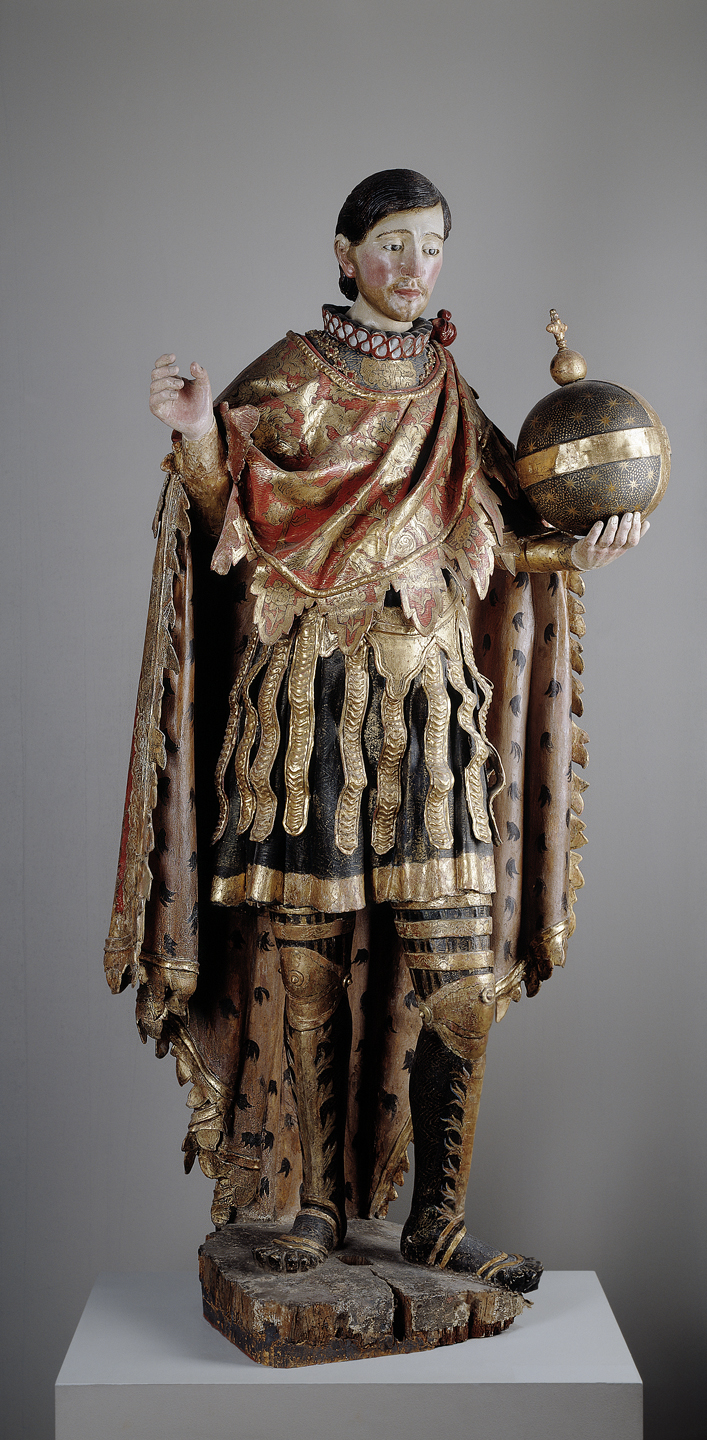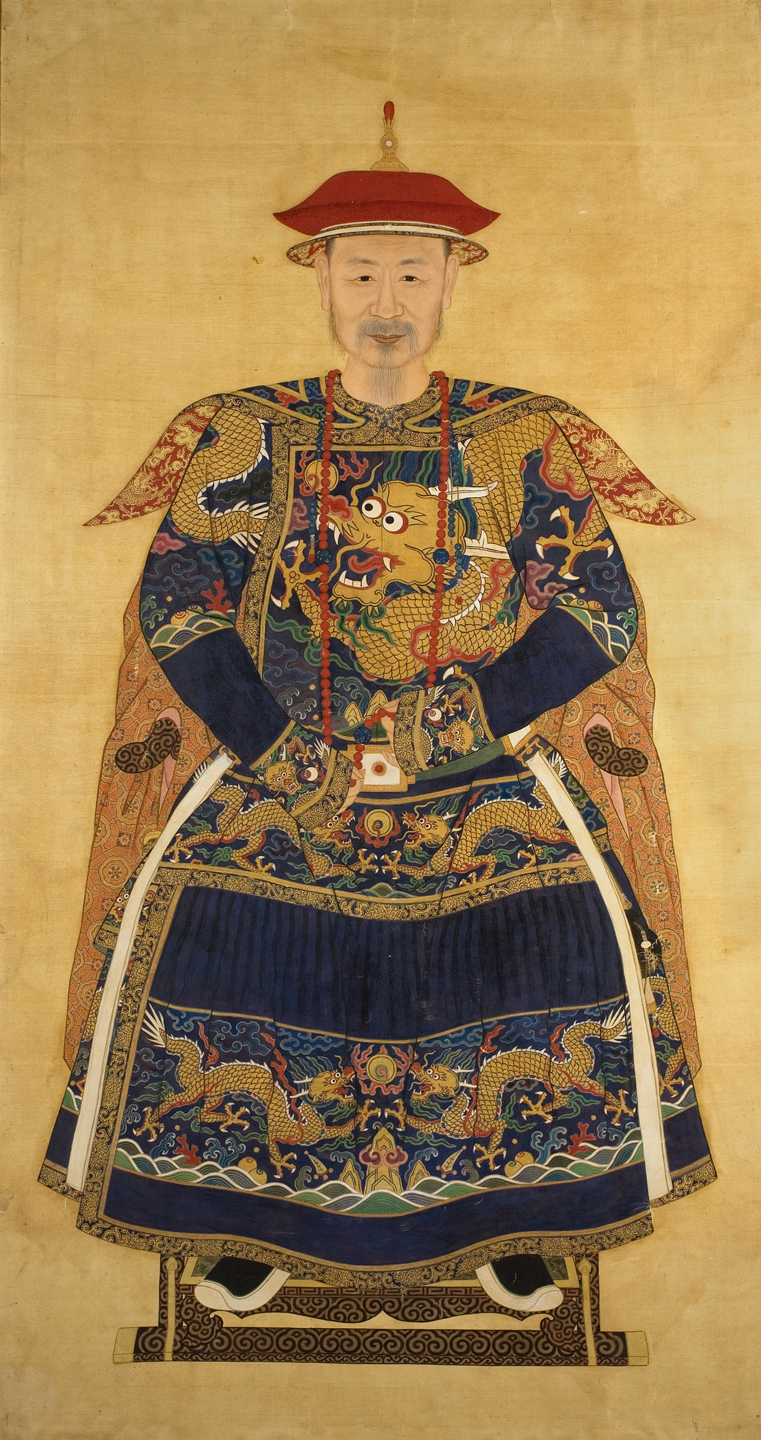After learning about the life of St. Ferdinand, students will identify popular figures who are worshipped as royalty in today’s society and write an argumentative piece either supporting or denouncing the icon’s popularity. Students will then choose a symbol they think represents their pop icon and make a collage communicating their beliefs.
Students will be able to:
- compare the life of a historic figure to popular figures of today;
- write an argumentative piece expressing their beliefs; and
- create a collage with a variety of artistic materials representing the beliefs they expressed in their writing assignment.
Lesson
- Warm-up: Ask the students to create a list of their favorite songs. Have a list of oldies songs already compiled (e.g. That Thing You Do, Hitchin’ a Ride, This Magic Moment, Blue Moon, In The Mood, Born To Be Wild, any songs that remind you of your high school days!). Share the lists out loud as a group, seeing if any of the songs overlap, if the students recognize the oldies songs, and if you recognize the students’ favorite songs. Ask the students questions such as: What characteristics attract you to a certain song or artist (e.g. lyrics, instruments, dance beat, etc.)? What characteristics do you think attract older generations to their favorite music? Are the characteristics similar or different? If the attributes are similar, how can it be that generations have radically different tastes in music but are attracted to the same things? What do you think has changed over the years?
- Display St. Ferdinand, King of Spain for the students to see. Using the About the Art sheet, explain that Ferdinand became King of Spain at the age of 18. Known as a wise and just ruler, Ferdinand was canonized by the Catholic Church for reclaiming much of Spain for Christianity. St. Ferdinand was recognized not only for being King of Spain but also because of his contributions to a cause that, at the time, was extremely important for his territories. He believed in a cause and dedicated his life to the movement.
- Explain to the students that today they will be going through magazines and finding photos of figures who are worshipped in today’s society. Distribute magazines and scissors and have the students cut out images of people who have made some sort of contribution, either positive or negative, to today’s society. Students may cut out images of politicians, actors/actresses, musicians, models, journalists, etc.
- After all the students have chosen a figure, discuss whether they think their icons are worthy of being photographed, recognized, and worshipped as modern day “royalty.” Remind them of the warm-up activity. Even though the music the class discussed spans many years, people are still drawn to music for similar reasons. Even though decades have passed since St. Ferdinand lived, certain characteristics such as dedication, passion, and loyalty are still thought of as worthy of being recognized.
- Have the students write an argumentative piece in support of or denouncing the popularity and status of their icon. Prompt them with questions such as: What contribution(s) has this person made to society (e.g. lobbied for a particular bill, created a charity, donated money, created an unrealistic body image in young girls, performed amazing concerts, etc.)? Did the contributions have a positive or negative effect? Are the contributions something that will be remembered a hundred years from now? Do you think this person is worthy of being considered modern day “royalty”?
Day 2
- Today the students will continue exploring the idea of modern day “royalty.” Display the sculpture of St. Ferdinand again for student to see. This time, focus on the artistic qualities of the piece: the elaborate clothing, cape, tunic, and especially the orb in his hand.
- Using the About the Art sheet, explain the significance of the orb and how it represents St. Ferdinand’s efforts to spread Christianity throughout the Iberian Peninsula.
- Return to the magazine images of the students’ icons. Have the students brainstorm objects their icon could carry, wear, hold, etc. that would support their argument piece from yesterday. For example, a student who wrote about how models provoke an unrealistic idea of body image could list objects such as diet pills, revealing clothing, etc. A student who wrote about a politician could list objects such as a copy of the Constitution, the American flag, etc.
- Distribute a piece of 11 x 17 inch paper, colored pencils or markers, and glue to each student. Have them glue their magazine cut out to the paper and draw in the objects they listed to represent their written ideas through an artistic medium.
- Display the collages and essays next to each other as representations for how ideas can be expressed in multiple ways.
Materials
- Paper and pen/pencil
- 11 x 17 inch piece of paper for each student
- Magazines
- Glue
- Scissors
- Colored pencils or markers
- About the Art sheet on St. Ferdinand, King of Spain (found at the end of the lesson plan) or student access to this part of Creativity Resource online
- One color copy of the sculpture for every four students, or the ability to project the image onto a wall or screen
Standards
- Visual Arts
- Critical Thinking & Reasoning
- Information Literacy
- Invention
- Self-Direction
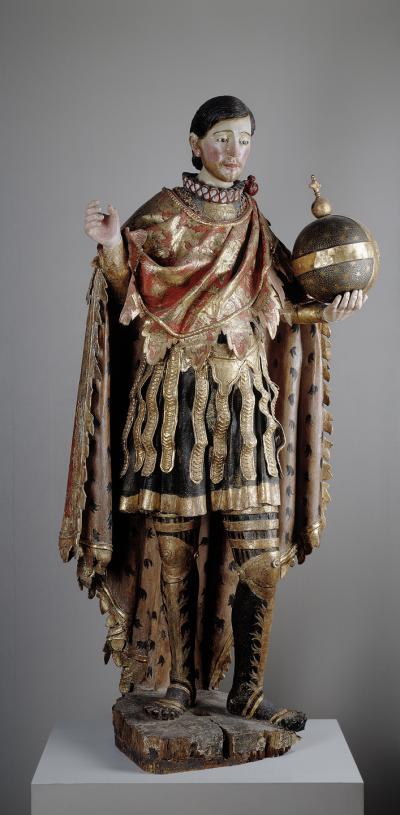
St. Ferdinand, King of Spain
Artist not known, Mexico
About 1730–1760
Height: 76 in.
Gift from Sam Houston in honor of Ms. Helen Bonfils, 1956.91
Photograph © Denver Art Museum 2009. All Rights Reserved.
The artist who created this object used various techniques to turn a wooden sculpture into a life-like depiction of St. Ferdinand. For fabric areas, the artist used a technique referred to in Spanish as estofado [ES-toe-FAH-doe]. When using the estofado technique, the artist would first cover the wood with gesso, or base paint, mixed with a brownish-red pigment called bole. Tissue-thin sheets of hammered gold were then applied to the bole base. Next, the artist would apply paint over the gold leaf. The paint layer was then etched through to reveal the gold leaf underneath. To depict areas of skin, such as the face and hands, the artist used a technique known as encarnación [EN-car-nah-see-OWN]. Similar to the estofado technique, the artist would begin by covering the carved wood with white gesso, which was then painted over with flesh-toned paint. A layer of clear, glossy varnish was applied over the paint and gently sanded smooth. The artist would repeat the process of applying paint and sanding it until the buildup of layers resulted in a glowing surface, imitating real skin.
St. Ferdinand, or Ferdinand III, was king of Castile and León in Spain during the early 1200s. Born near Salamanca, Spain, he became king in 1217 at the age of eighteen. He inherited the kingdom of Castile from his mother and the kingdom of León from his father, permanently uniting those areas for the first time and forming the core of what would later become Spain. Known as a wise and just ruler, Ferdinand was instrumental in the struggle to reclaim large areas of the Iberian Peninsula, which included Spain and Portugal, from Muslim occupation. Ferdinand had grown up during a period of intense efforts to reclaim the area for the Christians and, as a young king, continued the movement and re-conquered many cities. Ferdinand died in 1252 and was buried in a crypt underneath his chapel in the Cathedral of Seville. He was buried wearing the simple robe and rope belt of a Franciscan friar rather than the royal clothing of a king. He was canonized, or declared a saint, by the Catholic Church in 1671 for his efforts in reclaiming much of Spain for Christianity.
In Spain and Latin America, images of St. Ferdinand are often paired with images of his younger cousin, St. Louis of France, who also became a saint as a result of his religious crusades. Artists and architects of cathedrals in the New World often adorned altars with pairs of statues depicting European royalty who became saints. These altars were known as Altars of the Kings. The cathedral altar in Querétero, Mexico, where this statue is believed to have come from, was dismantled in the 1800s. Its matching statue of St. Louis of France is in a private collection in Mexico City.
Details

Estofado
The artist used the estofado technique to create an imitation of the elaborate brocaded fabrics of the period. Even though this statue is made of wood, notice how the areas of fabric seem to hang as they would if they were made of cloth.
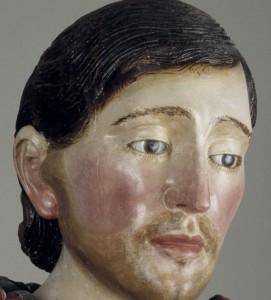
Encarnación
The artist used the encarnación technique on St. Ferdinand’s face and hands to create a glowing surface that looks like real skin.
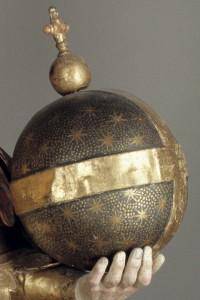
Orb
Although St. Ferdinand’s symbol is a greyhound, he is more frequently depicted holding an orb topped with a cross in one hand, and a flag with the emblems of Castile and León in the other. This sculpture only depicts an orb. The orb symbolizes St. Ferdinand’s efforts to spread Christianity throughout the Iberian Peninsula.
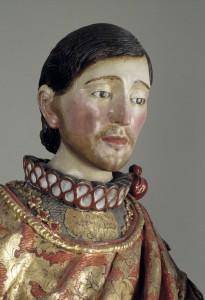
Expression
Notice how St. Ferdinand looks down with a calm expression. This statue would have been placed high on an altar, looking down at the people below.
Funding for object education resources provided by a grant from the Morgridge Family Foundation. Additional funding provided by the William Randolph Hearst Endowment for Education Programs, and Xcel Energy Foundation. We thank our colleagues at the University of Denver Morgridge College of Education.
The images on this page are intended for classroom use only and may not be reproduced for other reasons without the permission of the Denver Art Museum. This object may not currently be on display at the museum.
